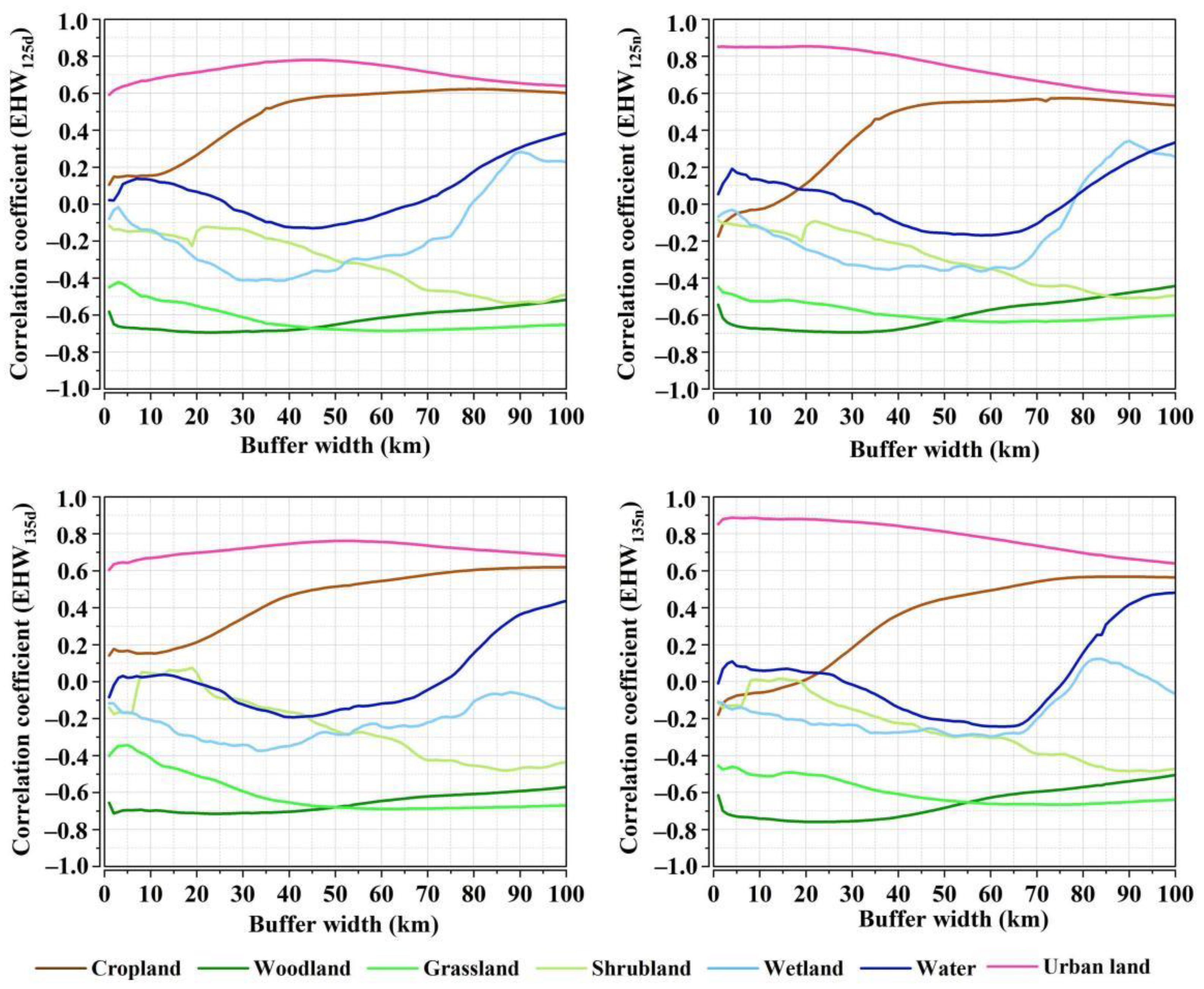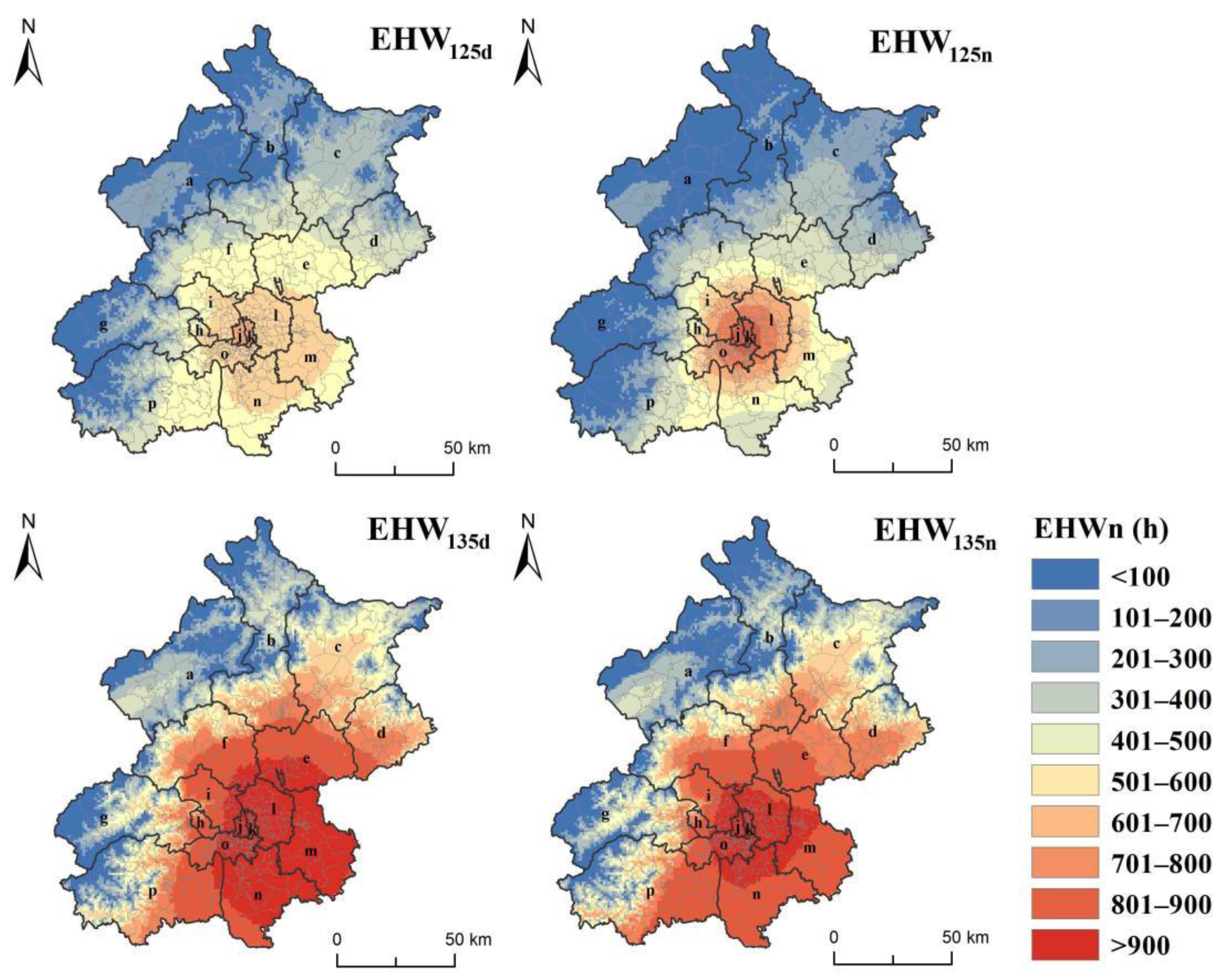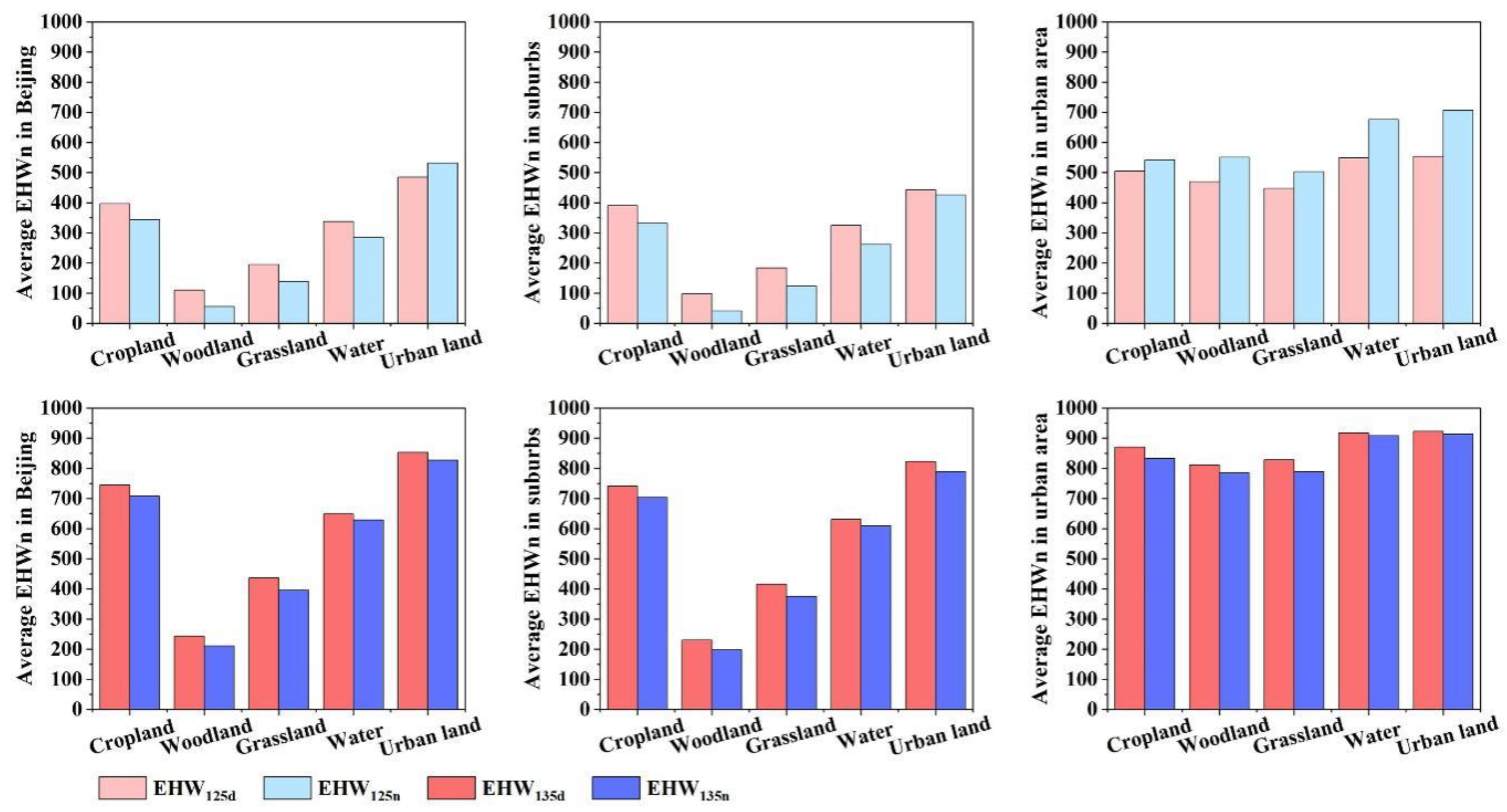Assessing the Spatial Variability of Daytime/Nighttime Extreme Heat Waves in Beijing under Different Land-Use during 2011–2020
Abstract
1. Introduction
2. Materials and Methods
2.1. Study Area
2.2. Data Collection and Preprocessing
2.2.1. Meteorological Data
2.2.2. Land Cover
2.2.3. Population Density
2.2.4. GDP
2.2.5. DEM
2.3. Quantification of Extreme Heat Waves and Spatial Mapping
3. Result Analysis
3.1. Performance Evaluation of the Interpolation Models for Cumulative Hours of Urban Extreme Heat Waves
3.2. Spatial Pattern Analysis of Cumulative Hours of Extreme Heat Waves during the Day/Night
3.3. Comparison of Accumulated Hours of Day/Night Extreme Heat Waves for Different Land-Use Types
3.4. Influence of Different Spatial Combination Patterns of Land-Use Type on the Cumulative Hours of Day/Night Extreme Heat Waves
3.5. Mitigation Effects of Woodland and Water on Cumulative Hours of Day/Night Extreme Heat Waves in Beijing
4. Discussion
5. Conclusions
- The urban day/night extreme heat waves cumulative hourly interpolation models were established; the correlations were highly significant at p < 0.01, both the significance test and R2 analysis showed that the models have good performance, and the accuracy of interpolation was high;
- The spatial distribution of the cumulative hours of day/night extreme heat waves in Beijing is “high inside and low outside; high in the south and low in the north”; a circle structure radiates from the central city to the suburbs. During 2016–2020, the annual cumulative hours of extreme heat waves in the daytime and in the nighttime were 95.06% and 115.70% higher than those of 2011–2015;
- The order of land-use types for cumulative hours of land-surface extreme heat waves in Beijing was as follows: urban land > cropland > water > grassland > woodland. In most cases, the cumulative hours of extreme heatwaves during the day were greater than those at night for cropland, woodland, grassland, water, and urban land;
- The increase associated with urban land in the cumulative hours of extreme heat waves at night is greater than that in the daytime. The mitigation effects of woodland and water on the cumulative hours of extreme heat waves are stronger at night than in the daytime, and the mitigation effect of woodland is stronger than that of water.
Supplementary Materials
Author Contributions
Funding
Institutional Review Board Statement
Informed Consent Statement
Data Availability Statement
Acknowledgments
Conflicts of Interest
References
- Luber, G.; McGeehin, M. Climate change and extreme heat events. Am. J. Prev. Med. 2008, 35, 429–435. [Google Scholar] [CrossRef] [PubMed]
- Patz, J.A.; Campbell-Lendrum, D.; Holloway, T.; Foley, J.A. Impact of regional climate change on human health. Nature 2005, 438, 310–317. [Google Scholar] [CrossRef] [PubMed]
- Bonan, G.B. Effects of Land Use on the Climate of the United States. Clim. Chang. 1997, 37, 449–486. [Google Scholar] [CrossRef]
- Findell, K.L.; Shevliakova, E.; Milly, P.C.D.; Stouffer, R.J. Modeled impact of anthropogenic land cover change on climate. J. Clim. 2007, 20, 3621–3634. [Google Scholar] [CrossRef]
- Ge, R.F.; Wang, J.L.; Zhang, L.X. Impacts of urbanization on the urban thermal environment in Beijing. Acta Ecol. Sin. 2016, 36, 6040–6049. (In Chinese) [Google Scholar]
- Hu, A.G. Urbanization as an engine of China’s economic growth. Popul. Sci. China 2003, 2003, 5–12. (In Chinese) [Google Scholar]
- Feng, Y.Y.; Hu, T.G.; Zhang, L.X. Impacts of structure characterisitics on the thermal environment effect of city parks. Acta Ecol. Sin. 2014, 34, 3179–3187. (In Chinese) [Google Scholar]
- Li, X.B. International research on environmental consequence of land use/cover change. Adv. Earth Sci. 1999, 14, 395–400. (In Chinese) [Google Scholar]
- Stathopoulou, M.; Cartalis, C. Daytime urban heat islands from Landsat ETM+and Corine land cover data: An application to major cities in Greece. Sol. Energy 2007, 81, 358–368. [Google Scholar] [CrossRef]
- Yue, W.Z.; Xu, L.H. Thermal environment effect of urban land use type and pattern—A case study of central area of Shanghai city. Sci. Geogr. Sin. 2007, 27, 243–248. (In Chinese) [Google Scholar]
- Polydoros, A.; Cartalis, C. Assessing the impact of urban expansion to the state of thermal environment of peri-urban areas using indices. Urban Clim. 2015, 14, 166–175. [Google Scholar] [CrossRef]
- Sharma, R.; Chakraborty, A.; Joshi, P.K. Geospatial quantification and analysis of environmental changes in urbanizing city of Kolkata (India). Environ. Monit. Assess. 2015, 187, 4206. [Google Scholar] [CrossRef] [PubMed]
- Rasul, A.; Balzter, H.; Smith, C.L. Applying a normalized ratio scale technique to assess influences of urban expansion on land surface temperature of the semi-arid city of Erbil. Int. J. Remote Sens. 2017, 38, 3960–3980. [Google Scholar] [CrossRef]
- Zhang, X.L.; Zhang, S.W.; Li, Y. Correlation between urban thermal environment effect and land use pattern in Changchun. Resour. Sci. 2008, 30, 1564–1570. [Google Scholar]
- Guo, A.; Yang, J.; Sun, W.; Xiao, X.; Cecilia, J.X.; Jin, C.; Li, X. Impact of urban morphology and landscape characteristics on spatiotemporal heterogeneity of land surface temperature. Sustain. Cities Soc. 2020, 63, 102443. [Google Scholar] [CrossRef]
- Guo, G.; Wu, Z.; Xiao, R. Impacts of urban biophysical composition on land surface temperature in urban heat island clusters. Landsc. Urban Plan. 2015, 135, 1–10. [Google Scholar] [CrossRef]
- Estoque, R.C.; Murayama, Y.; Myint, S.W. Effects of landscape composition and pattern on land surface temperature: An urban heat island study in the megacities of Southeast Asia. Sci. Total Environ. 2017, 577, 349–359. [Google Scholar] [CrossRef]
- Zhang, L.J.; Chen, H.; Zhang, J.F. Study on the relationship between urban expansion and land surface thermal environment change in Harbin City. Areal Res. Dev. 2010, 29, 49–52. (In Chinese) [Google Scholar]
- Sun, J.; Zhang, H.; Whang, Q. Correlations between land cover type and surface temperature of the Taihu Lake basin based on HJ-1 satellite data. Res. Environ. Sci. 2011, 24, 1291–1296. (In Chinese) [Google Scholar]
- Zhao, Z.Q.; Li, L.G.; Wang, H.B. Study on the relationships between land use and land surface temperature in Shenyang urban districts. J. Meteorol. Environ. 2016, 32, 102–108. (In Chinese) [Google Scholar]
- Yaung, K.L.; Chidthaisong, A.; Limsakul, A.; Varnakovida, P.; Nguyen, C.T. Land Use Land Cover Changes and Their Effects on Surface Air Temperature in Myanmar and Thailand. Sustainability 2021, 13, 10942. [Google Scholar] [CrossRef]
- Connors, J.P.; Galletti, C.S.; Chow, W.T.L. Landscape configuration and urban heat island effects: Assessing the relationship between landscape characteristics and land surface temperature in Phoenix, Arizona. Landsc. Ecol. 2013, 28, 271–283. [Google Scholar] [CrossRef]
- Asgarian, A.; Amiri, B.J.; Sakieh, Y. Assessing the effect of green cover spatial patterns on urban land surface temperature using landscape metrics approach. Urban Ecosyst. 2015, 18, 209–222. [Google Scholar] [CrossRef]
- Yuan, S.; Ren, C.; Meng, C.; Lau, K.K.; Lee, T.C.; Wong, W.K. Assessing spatial variability of extreme hot weather conditions in Hong Kong: A land use regression approach. Environ. Res. 2019, 171, 403–415. [Google Scholar]
- Hua, J.Y.; Zhang, X.Y.; Ren, C.; Yuan, S.; Lee, T.-C. Spatiotemporal assessment of extreme heat risk for high-density cities: A case study of Hong Kong from 2006 to 2016. Sustain. Cities Soc. 2021, 64, 102507. [Google Scholar] [CrossRef]
- Yao, Y.; Chen, X.; Qian, J. The research progress of urban surface thermal environment. Acta Ecol. Sin. 2018, 38, 1134–1147. (In Chinese) [Google Scholar]
- Oke, T.R.; Mills, G.; Christen, A. Urban Climates; Miao, S.; Wang, X.; Wang, C.; et al., Translators; China Meteorological Press: Beijing, China, 2020; Volume 27. [Google Scholar]
- Cao, Q.; Yu, D.Y.; Sun, Y. Research progress on the quantitative relationship between land use/cover change and climate change. J. Nat. Resour. 2015, 30, 880–890. (In Chinese) [Google Scholar]
- Wang, J.; Qian, Y.G.; Han, L.J. Relationship between land surface temperature and land cover types based on GWR model: A case of Beijing-Tianjin-Tangshan urban agglomeration, China. Chin. J. Appl. Ecol. 2016, 27, 2128–2136. (In Chinese) [Google Scholar]
- Buyantuyev, A.; Wu, J. Urban heat islands and landscape heterogeneity: Linking spatiotemporal variations in surface temperatures to land-cover and socioeconomic patterns. Landsc. Ecol. 2010, 25, 17–33. [Google Scholar] [CrossRef]
- Li, S.C.; Zhao, Z.Q.; Xie, M.M.; Wang, Y.G. Investigating spatial non-stationary and scale-dependent relationships between urban surface temperature and environmental factors using geographically weighted regression. Environ. Model. Softw. 2010, 25, 1789–1800. [Google Scholar] [CrossRef]





| EHW125d | EHW125n | EHW135d | EHW135n | |
|---|---|---|---|---|
| Level 1, 2, 3 | 68 | 94 | 33 | 33 |
| Level 4, 5, 6 | 236 | 107 | 35 | 38 |
| Level 7, 8, 9 | 27 | 130 | 102 | 129 |
| Level 10 | - | - | 161 | 131 |
| EHW125d (h) | EHW125n (h) | EHW135d (h) | EHW135n (h) | |
|---|---|---|---|---|
| Woodland (0%) & Water (0%) | 444 | 418 | 849 | 812 |
| Woodland (100%) | 33 | 0 | 97 | 68 |
| Water (100%) | 277 | 202 | 548 | 533 |
| Woodland (>50%) | 114 | 57 | 251 | 218 |
| Water (>50%) | 291 | 226 | 565 | 549 |
Publisher’s Note: MDPI stays neutral with regard to jurisdictional claims in published maps and institutional affiliations. |
© 2022 by the authors. Licensee MDPI, Basel, Switzerland. This article is an open access article distributed under the terms and conditions of the Creative Commons Attribution (CC BY) license (https://creativecommons.org/licenses/by/4.0/).
Share and Cite
Su, X.; Wang, F.; Zhou, D.; Zhang, H. Assessing the Spatial Variability of Daytime/Nighttime Extreme Heat Waves in Beijing under Different Land-Use during 2011–2020. Land 2022, 11, 1786. https://doi.org/10.3390/land11101786
Su X, Wang F, Zhou D, Zhang H. Assessing the Spatial Variability of Daytime/Nighttime Extreme Heat Waves in Beijing under Different Land-Use during 2011–2020. Land. 2022; 11(10):1786. https://doi.org/10.3390/land11101786
Chicago/Turabian StyleSu, Xiaokang, Fang Wang, Demin Zhou, and Hongwen Zhang. 2022. "Assessing the Spatial Variability of Daytime/Nighttime Extreme Heat Waves in Beijing under Different Land-Use during 2011–2020" Land 11, no. 10: 1786. https://doi.org/10.3390/land11101786
APA StyleSu, X., Wang, F., Zhou, D., & Zhang, H. (2022). Assessing the Spatial Variability of Daytime/Nighttime Extreme Heat Waves in Beijing under Different Land-Use during 2011–2020. Land, 11(10), 1786. https://doi.org/10.3390/land11101786







